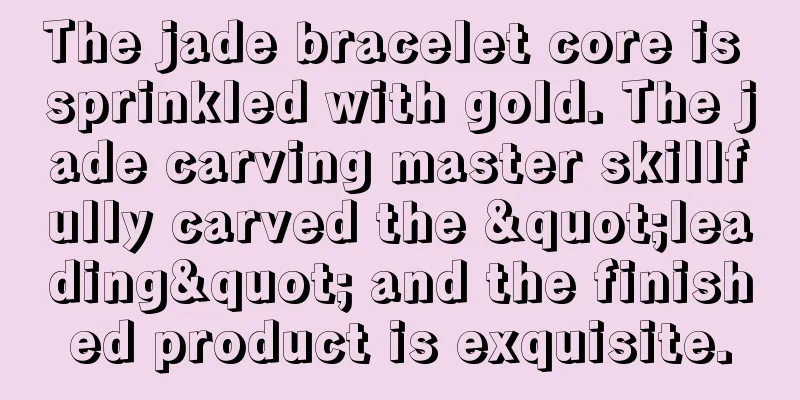A piece of cottony green jade bracelet core, after being designed by a jade carver, instantly improves its grade!

|
Everyone wants to own jadeite with top-quality, pure color and flawless appearance, but in reality, jadeite of this quality is often very expensive, and what we often come into contact with is jade material of medium and low quality. Sometimes, although the material in the photo has many surface flaws, after careful design by the jade carver, the grade of the finished product can be improved by several levels! Just like the work I’m going to share today, it’s an example of upgrading your work through carving. This glutinous bracelet core, after being removed, has a green tint which is relatively bright, but the black spots and large cotton wool visible to the naked eye have lowered the value of the entire material a lot. Materials like this require the jade carver's ability to remove dirt and cotton and to skillfully use colors. It is no exaggeration to say that for materials like this, the value of the finished jade product is determined by the jade carver's skill. When faced with this bracelet core, the first subject matter that the jade carver considers is landscape or dragon plaque. These two subjects are more suitable for removing flaws on the bracelet core because of their complex lines. After analysis and consideration, the final design is mountains and waters: the floating green position on the bracelet core is cleverly designed as mountains, and the position with more white cotton is designed as lake water. The black spots hidden in the cotton are removed through the combination of high and low, virtual and real, and the design of the fisherman fishing can cleverly reduce the impact of the white cotton on the aesthetics. The front is carved in shallow relief, and the jade carver outlines the contours of the landscape according to the designed lines. Although it is a shallow relief, the images of the mountains and figures are very three-dimensional, which reflects the jade carver's control of lines. The back is also a shallow relief creation, the difference is that the water adjustment technique is added to the back. Through water adjustment, the light transmittance of the finished product can be greatly improved, making the glutinous material more glossy and the green more blooming. The jade carver used some tricks when polishing the finished product, and applied matte polishing in some local areas. This operation enhanced the layering of the finished pattern while further reducing the impact of cotton weight on the beauty. The water adjustment technique greatly improves the overall light transmittance of the finished landscape painting, and the green color also becomes more vivid as desired. Finally, look at the translucent picture. The dirty feeling formed by the black spots on the wool material and the heavy cotton is gone, and what is displayed is the heart-stirring bright green. fcgc66 fcgc99 |
>>: How to judge jade carving? What is considered good?
Recommend
What kind of jade is good? Jade is not expensive or cheap, but people's hearts are high or low.
There are so many types of jade that many people ...
What does jade quality mean? When it comes to appearance, should we look at the type or the color first?
In fact, the term "appearance" is not d...
The Last Empress: A Life Witnessed by Jade Jewelry
When it comes to jadeite in the Qing Dynasty, eve...
The past and present of black jade
As the name suggests, black jadeite is the same c...
How much do you know about the value of jade?
Maybe buying jade has become a habit for many peo...
Jade carving, the whole process from rough design to finished product, this is craftsmanship!
Jade carving itself is a design and an idea. Only...
How to identify the authenticity of jadeite
Nowadays, many friends like to collect jadeite th...
Jade cannot be made into a useful object without being carved. After careful carving, ordinary raw stones can be transformed into exquisite jade leaves!
The piece of material below was bought by a young...
The easiest way to identify jadeite
It is a recognized fact that the jade industry is...
Cut out the jade material full of cracks and make them all into egg-shaped surfaces in one go! Hundreds of them are very generous!
Nowadays, many people like jade, and the raw mate...
practical! Keep these points in mind and you can easily buy good jadeite
The century-old four-word formula for jadeite sel...
Jade Carver's Reference - 5 "37 Laws" of Jade Carving
If jade is not carved, it cannot become a useful ...
The vegetable with the most cultural connotation! The triple traditional meaning of Chinese cabbage
There are many kinds of vegetables all over the c...
Such bold and avant-garde jade carvings are difficult to understand at first glance, but they are endless when you savor them carefully!
Jade is superior to stone because of its texture,...
Jade Collection Value
1. Investment value preservation Good jade is bec...









